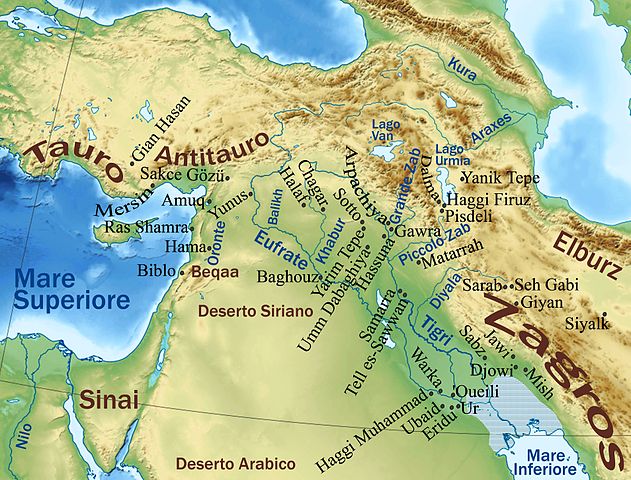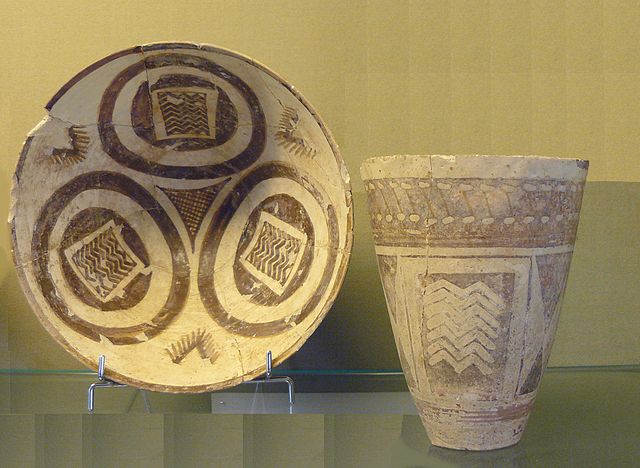
| GODIN TEPE
Godin Tepe, Iran
Important sites in the Near East during the Ubaid period. Seh Gabi on the right also marks the location of Godin Tepe Godin Tepe is an archaeological site in western Iran, situated in the valley of Kangavar in Kermanshah Province. Discovered in 1961, the site was excavated from 1965 to 1973 by a Canadian expedition headed by T. Cuyler Young Jr. and sponsored by the Royal Ontario Museum (Toronto, Ontario, Canada). The importance of the site may have been due to its role as a trading outpost in the early Mesopotamian trade networks.
Archaeology
:
Seh
Gabi :
Originally, the excavations at Godin concentrated on levels II (ended c. 500 BC?) to V (c. 3200 BC-3000 BC), but the transition from the Neolithic to Chalcolithic was studied primarily at Seh Gabi.
The earliest pottery found was of the painted pottery traditions, including J ware (Godin pre-XI), and impressed Dalma ware (de:Dalma Tepe), belonging to Godin XI/X. J ware is related to Halaf culture pottery.
Dalma ware is very similar to the pottery traditions from the highlands north of Godin, especially from the area of Lake Urmia.
Level VIII :
Ubaid pottery at the Oriental Institute Museum, Chicago Level VIII is dated 4200-4000 BCE, contemporary with Terminal Ubaid period. According to Mitchell Rothman, at this time, during the Late Chalcolithic 1 period (LC 1), some substantial trading networks emerged in the area for trade in metals, and in precious or semi-precious stones, "During the time of Godin VIII, the LC 1, a real increase in the movement of these goods is evident across the region. For example, lapis lazuli, a semi-precious blue stone known to occur naturally only in the Badakshan area of northeastern Afghanistan, began to appear in LC1 sites in significant amounts (Herman 1968)."
Thus, the importance of Godin Tepe may have been due to its position serving the early trade from the east, from as far as afghanistan, and to the Mesopotamian flood plain. For example, lapis-lazuli was brought from Badakhshan in Afghanistan to Mesopotamia.
Level V :
Goblet and cup, Iran, from Susa, 4th millennium BC - Ubaid period; goblet height c. 12 cm; Sèvres – Cité de la céramique, France During the 1973 campaign, level V was excavated through a deep cut from the citadel. It was occupied during the period 3200 BC-3000 BC. At the end of level V there was a clear gap in the settlement sequence. There were signs of fire, such as room 22 whose roof was burned. The houses were in general well-preserved and contained many artefacts, but objects made of the precious metal were lacking. The archaeological evidence support the idea the settlement was abandoned quickly, but in an orderly manner.
The pottery of level V show influences from the Uruk culture, with parallels at Susa, Uruk (IV) and Nippur. The typical Jemdet Nasr tall storage jars, known from Nippur, and the bevelled rim bowls of Uruk are missing however.
Cuyler-Young suggested the existence of Elamite trading posts at the site during this period, established by merchants from Susa.
Thirteen seal impressions and two cylinder seals were found at level V. They were obviously produced locally, as shown by the discovery of an uncarved cylinder. The seal impressions show a parallel with Uruk, Susa and other sites in Khuzestan. They were partly decorated with drill holes. Steatite served as raw material for these, sometimes treated with tempering.
At level V some 43 clay tablets were found of which 27 were preserved in one piece. They contained primarily accounts, like those discovered at temporary Proto-Elamite and Uruk period sites in western Iran and Mesopotamia.
Early
wine-making :
Level
IV :
The only notable architectural remains of this period consist of a number of plastered hearths .T.Cuyler Young Jr. defined three main groups of pottery for Level IV. Two of these groups belong to Transcaucasian Early Bronze Age Culture. One of these groups bears two types of coarse ware tempered with coarse grit. One of these types is characterized by a grey-black burnished surface mostly with contrasting colours in the interior and exterior of the vessels. This type of coarse ware was used for producing bowls entirely. Conical bowls decorated with incised and excised designs are common; the incised designs are occasionally filled with a whitish paste. The second type of coarse ware is lighter in colour, often tan or pinkish buff. The surface of the vessels is either burnished or plain.
Besides bowls there are jars with protruding rims and concave or recessed necks.
The second group of Transcaucasian Pottery found at Godin Tepe was classified as Common Ware. The fabric of this group was tempered by medium-fine grit and was not well-fired. This group of pottery has the same colour range like the coarse ware. The surfaces are highly burnished though the vessels with a light interior and dark exterior are predominant. The forms consist entirely of cups, including the recessed neck types. The decoration is similar in style and technique to the previous coarse wares, but the excised designs are less common.
Level
III :
Level
II :
Godin was again abandoned during the 6th century BC, perhaps as a result or in anticipation of the expansion of Cyrus the Great (c. 550 BC) (Brown 1990) or due to the interruption of a social stratification and secondary State formation process after the fall of Assyria.
Level
I :
Source :
https://en.wikipedia.org/ |



